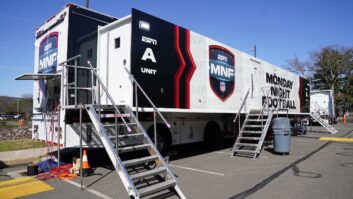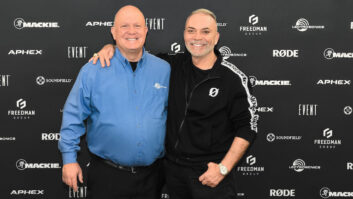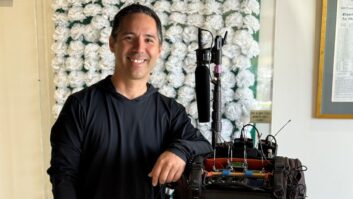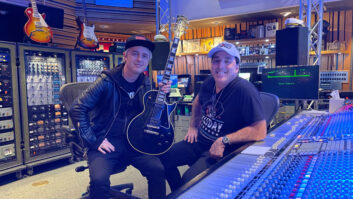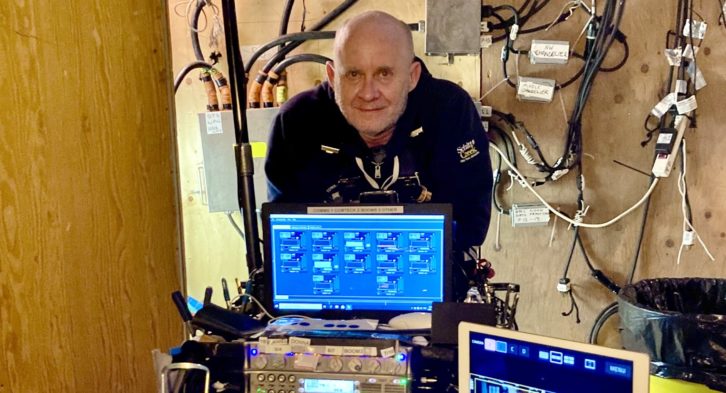
Los Angeles, CA (November 10, 2020) —Schitt’s Creek, produced by the Canadian Broadcasting Corporation (CBC) and distributed by Pop TV in the U.S., just set a new record for the most Emmy® Awards won in a single season: nine, including Best Comedy Series. Co-creators and stars Eugene Levy and son Daniel picked up Best Comedy Actor and Best Supporting Actor, with Catherine O’Hara garnering Best Comedy Actress. In the runaway hit, the fictional Rose family’s riches-to-rags misfortune finds them living in the titular town they once purchased as a joke. Given the Levys’ creative hand, the show is chock full ad-libbing. This means the sound department needs to be ready for anything, which is why sound mixer Bryan Day packs an arsenal of Lectrosonics Digital Hybrid Wireless® equipment, including Venue and Venue2 modular receivers, four LR belt-pack receivers, three HMa plug-on transmitters, and eight SSM micro transmitters.
“I got the call to do season 6 literally two days before production was scheduled to begin,” says Day. “It was literally, ‘Wanna do Schitt’s Creek?’ I said, ‘Schitt yeah!’ Since so much of the script is ad-libbed, we rely heavily on boom mics, for which we use the HMa plug-ons. Then, every actor in the scene is also wearing an SSM. If one of them says something that’s just priceless and the boom doesn’t capture it, the SSM does. I depend on them without hesitation.”
The SSM has become Day’s go-to transmitter for two reasons. “The first thing I love about the SSM is the size,” he explains. “I can hide them almost anywhere. For example, the character Alexis [Anne Murphy] is a tiny woman, and there are often scenes where her wardrobe is pretty revealing. With Catherine O’Hara, her costumes are so much part of her character that you’re almost scared to disrupt that. So, the SSM’s size is really a savior.”
“My other favorite thing about the SSM is that you can literally plug any type of mic into it and optimize the settings,” Day continues. “There’s this menu on it called the Bias menu. It’s easy to find and logical, and it tunes the bias voltage, the phase, and the polarity for a variety of popular lav mics. So, whether you have a Countryman, a Sanken COS, a DPA, even a line-level input, it’s going to sound perfect.”
The pervasive ad-libbing makes for unpredictable dynamic range in the actors’ voices. The Venue and Venue2 receiver systems’ ability to host up to six dual-channel receiver modules keeps Day prepared for any such surprises: “I’ve had plenty of times where Dan Levy or another actor was shouting one second and then whispering the next, and again, it’s not scripted,” he explains. “First of all, the noise floor of the receivers is so good that amplifying soft-spoken dialogue is usually no problem. However, what I usually do is pair one transmitter with two receiver channels. These have different gain settings and I double-track everyone’s voice. This approach has never, ever let me down, no matter what the talent comes up with.”
LR receivers come into play for motion shots. “The Lectro LRs are super simple and super reliable,” says Day. “They live in my bag, and we use them for walk-and-talks where we’re not going to roll the entire audio cart down the street.”
Production realities on Schitt’s Creek make for crowded RF airspace, which Day navigates using Lectrosonics Wireless Designer software. “For big scenes, we might have up to 15 wireless mics going at once,” he points out. “On top of that, we’re on a soundstage next to other soundstages, so there might be 50 radio frequencies in my environment. Wireless Designer helps us coordinate with the other productions, so no one is stepping on anyone else. Beyond just being a display tool, it also lets me tune the receivers in an intuitive, visual way. It’s a saving grace.”
Asked to relate a specific crisis where the software played that role, Day laughs, “Let me say that we don’t have many ‘Oh, Schitt’ moments with sound because Lectrosonics prevents them from happening in the first place. But there was one time where we were in the same location about twice a week, with no problems. Suddenly, the RF started getting really crowded. Wireless Designer made it so easy to scan for new frequencies and retune the Venues. We didn’t skip a beat, and the rest of production didn’t notice anything.”
Day also flags Lectrosonics’ people and service as key to his loyalty: “Again, it’s once in a blue moon that something goes wrong. But if something does, their turnarounds for repairs and loaners are almost instantaneous. One time, we had a concern about sweat around the antenna in one situation where an SSM had to be right on someone’s skin. Not only did they modify our SSMs with a new antenna gasket, but they incorporated that into their design from then on. How many companies do that, basically with a smile on their face?”
Day concludes, “To say to the talent and the producers, ‘We can make this work without you changing what you do’ — that’s the Holy Grail for any sound guy. Lectrosonics lets me proceed with absolute confidence that I can do that, day in and day out.”
About Lectrosonics
Well respected within the film, broadcast, and theatre technical communities since 1971, Lectrosonics wireless microphone systems and audio processing products are used daily in mission-critical applications by audio engineers familiar with the company’s dedication to quality, customer service, and innovation. Lectrosonics received an Academy Scientific and Technical Award for its Digital Hybrid Wireless® technology and is a US manufacturer based in Rio Rancho, New Mexico. Visit the company online at www.lectrosonics.com.
